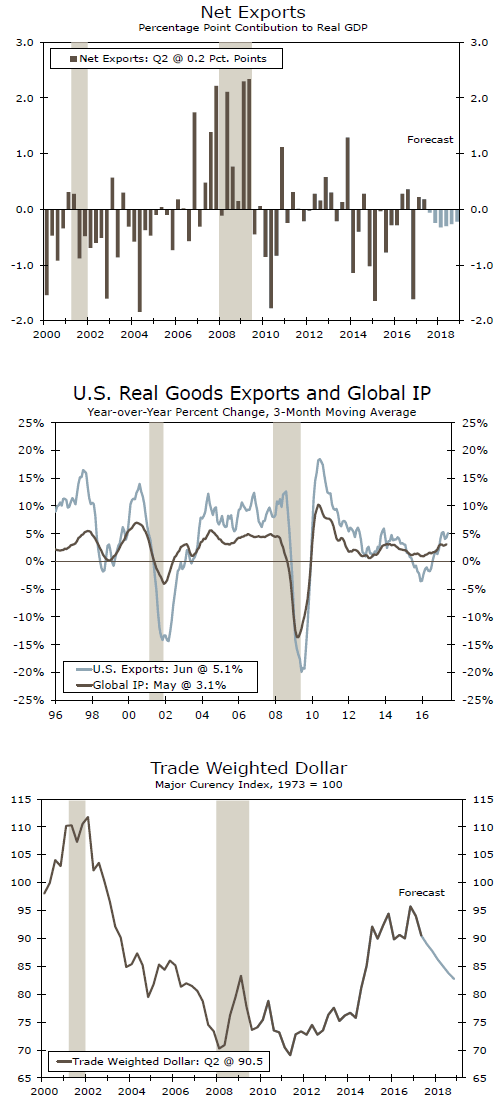We forecast that real net exports will exert a modest drag on U.S. real GDP growth in coming quarters. Foreign economic growth that is stronger than expected would lessen the drag from the external sector.
Net Exports Likely Will Exert Modest Drag on U.S. GDP Growth
As shown in the top chart, real net exports can have a volatile effect on U.S. real GDP growth on a quarter-by-quarter basis. That said, net exports have generally exerted a modest drag on overall GDP growth since the Great Recession ended in 2009. Looking forward, we forecast that real net exports will slice 0.2 to 0.3 percentage points from overall GDP growth through the end of 2018. Could net exports actually be accretive to GDP growth over our forecast horizon?
Net exports are simply the difference between exports and imports. So a decline in imports would boost real GDP, everything else equal. But an outright decline in imports is usually associated with recession. That is, reductions in domestic demand (consumer, fixed investment and government spending) pull down imports as well. But the decline in imports generally provides some offset on GDP growth from the drop in domestic demand. But falling imports usually do not prevent overall GDP from contracting when recessionary shocks hit the economy.
Export Growth Depends Largely on Foreign Economic Growth
A more benign way to realize stronger GDP growth from the external sector is via exports. So could exports actually grow strongly enough to deliver a positive boost to U.S. real GDP growth from overall net exports? As shown in the middle chart, U.S. export growth and the rate of economic growth in the rest of the world have a high degree of correlation. At present, exports are growing at roughly 5 percent on a year-ago basis and growth in global industrial production is clipping along at approximately 3 percent. In order for export growth to strengthen significantly, global economic activity would need to accelerate even further. Although we look for global growth to strengthen somewhat in coming quarters, a return to the 5 percent growth rates that characterized the middle years of the past decade seem to be a tall order.
Could a weaker dollar help to boost growth in American exports? Since the beginning of the year, the U.S. dollar has depreciated about 7 percent on a broad trade-weighted basis and our currency strategy team looks for further weakness in the greenback on a trend basis (bottom chart). However, the statistical analysis that we and other analysts have conducted over the years shows that the sensitivity of American export growth to changes in the value of the dollar is much lower than it is to changes in global economic growth. So, a dollar that is weaker than our current forecast would impart some upside potential to U.S. export growth, but it likely would not be a "silver bullet" either in terms of strong export growth.














